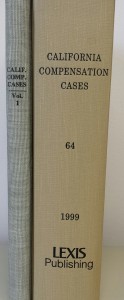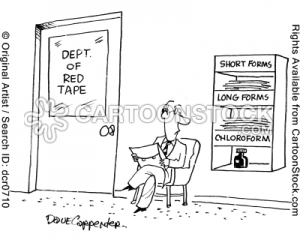A Cautionary Tale on Rushing to Recon
Be wary of knee-jerk reactions, dear readers. Often enough, a party receiving an adverse ruling by a workers’ compensation Judge will immediately rush to file a petition for reconsideration or removal. Don’t – weigh the options first!
The remedies of removal and reconsideration are considered by all parties, including applicants’ attorneys, defense attorneys, and the defendants themselves – whether self-insured employer or an insurer.
But, sometimes there’s really no point, and good counsel means going over the reasons for the action as well as the likelihood of success. If the goal is wheel spinning, then you’re doing something wrong.
In filing a petition for removal or reconsideration, it is VITAL that one follows the rules laid out by the WCAB. The commission is currently sporting 2 vacant seats, and if you look at any workers’ compensation lawyer’s library, you’ll see that the Lexis CCC reporter tomes have grown exponentially from the first volume in 1936 to the 64th in 1999.
Accordingly, even meritorious cases might be tossed aside for failure to follow the proper rules to allow the commissioners to address the flood of petitions.
In one recent case, Cheryl McMillin v. Monsanto Company, the WCJ, in his report and recommendation, pointed out two defects in the Petition for Reconsideration, and this serves as a wonderful opportunity to highlight these rules as a reminder to all.
By way of background, the defense obtained 3 dvds or 11 days of surveillance of the injured worker engaged in various activities including gardening. However, these DVDs were produced to the applicant’s attorney nearly six months after being received by the defense attorney, despite repeated letters requesting all sub rosa video be produced. Additionally, the QME appeared to be aware that the applicant engaged in these activities (as per the WCJ’s report), because the applicant had told him about them. She further testified (consistently) at trial to engaging in light gardening and short driving trips.
The WCJ, in his report, highlighted two procedural defects with the petition for reconsideration. The first was that Rule 10842(a): it is not enough to simply file for reconsideration and make legal arguments, the petitioner must make specific reference to the record and the exhibits. To that end, it is important to diligently make a clear record at trial and to vocally (and sometime repeatedly) make objections known.
Rule 10842 also provides some helpful examples to how to cite to the specific record, and practitioners would do well to review these examples prior to drafting the petition.
Additionally, when alleging newly discovered evidence or fraud, Rule 10856 requires a detailed offer of proof as to the specifics involved. It is, of course, very tempting to play one’s cards close to the chest and try to keep an element of surprise. It’s almost romantic and charming in its mystique – “grant this petition, oh ye commissioners, and I will dazzle you with my powers in hearings to come…”
Rule 10856 requires the names of witnesses to be produced, a summary of the testimony to be elicited, a description of any documents to be offered, the effect the evidence will have on the record, and, with regard to newly discovered evidence, why the evidence could not be produced prior to the submission of the case.
Now, bear in mind, a lot of times this is pretty easy to do – if the injured worker says she can’t pick up more than 10 pounds, and, after the trial, she thinks she’s home free and participates in a weightlifting competition, then you probably couldn’t obtain video of the events before they happened.
The petition also apparently cited an unpublished decision.
Let this be a cautionary tale for all of us that zealous advocacy must be tempered with due respect and regard for rules and procedures, for the applicants’ bar as well as the defense.
